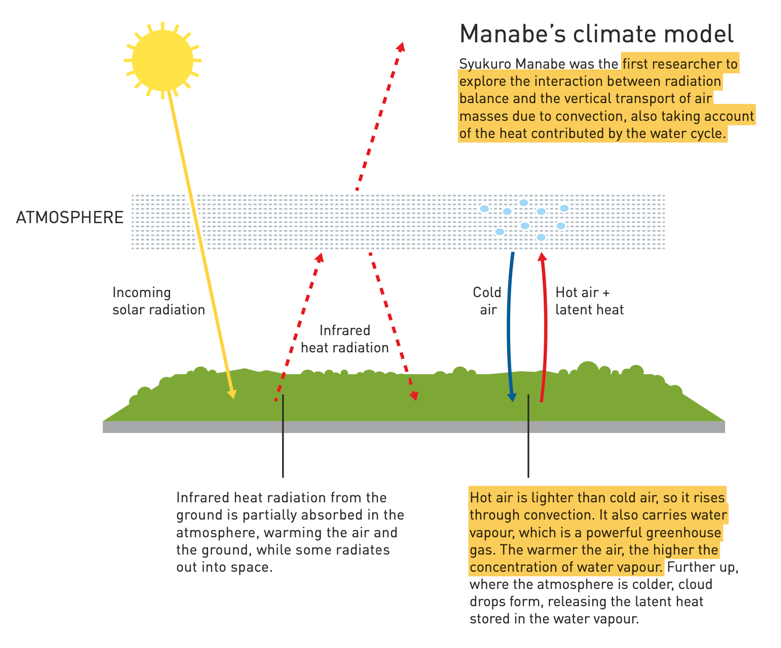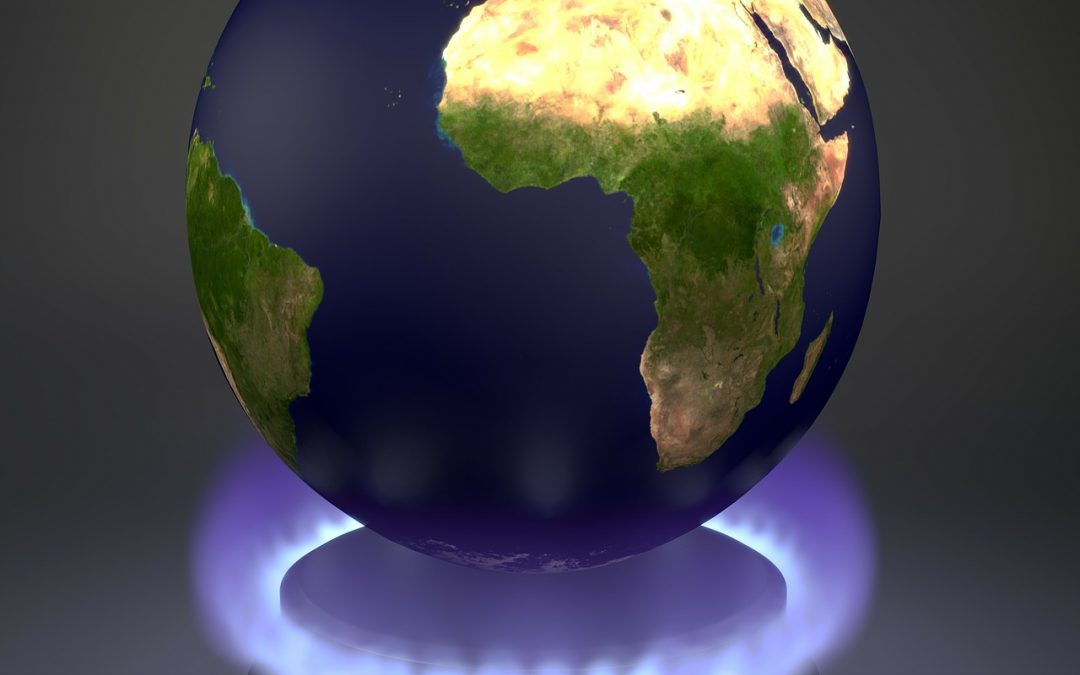In the year of the 26th Conference of the Parties on Climate Change of the United Nations (COP26), the Royal Swedish Academy of Sciences choses to award the Nobel Prize in Physics 2021 to Giorgio Parisi (for his studies on complex systems), but also to Syukuro Manabe and Klauss Hasselmann “ for the physical modeling of the Earth’s climate, quantifying variability and reliably predicting global warming ”.
These studies reinforce scientific awareness about how global warming is a direct consequence of human activities.
Here is an introduction to these discoveries.
INDEX:
1. Syukuro Manabe and the greenhouse effect
Syukuro Manabe – researcher at the University of Princeton – developed during the 1960s a physical model of the Earth’s climate , starting from the concept of the greenhouse effect of the atmosphere .
The Earth’s atmosphere is the gaseous envelope made up of gases and vapors in its lower part and mainly of ions and electrons in the upper part, held around the Earth by the Earth’s gravitational and magnetic fields.
With the term greenhouse effect we refer to the capacity of the Earth’s atmosphere to act precisely like the glass of a greenhouse, since:
a) It lets the solar rays at the electromagnetic spectrum of visible light pass through, thus hitting the Earth;
b) Instead, it retains part of the infrared rays that are re-radiated from the Earth’s soil when it is hit by the solar rays.
The greenhouse effect operated by the Earth’s atmosphere has a fundamental value: by retaining part of the infrared rays re-radiated from the ground, it allows the Earth to be heated.
In fact, it is estimated that, if there were no atmosphere capable of operating the greenhouse effect, the Earth’s surface temperature would barely reach -18°C.
The atmosphere is able to operate this greenhouse effect since it is composed of some gases able to retain the infrared rays. In particular, carbon dioxide – CO2 – is one of the main gases in our atmosphere with this capacity.
Although CO2 represents only the 0.04% of our atmosphere, a variation in its levels could significantly reduce or increase the greenhouse effect operated by our atmosphere. In both cases with catastrophic outcomes:
- If CO2 levels were to be halved it is estimated that we would lose the ability to hold the re-radiated energy to the point of entering a new ice age;
- If CO2 levels doubled, we would retain the re-radiated energy to such an extent that much of the planet would become unlivable due to the rise in Earth’s temperature.
Here we are now to Syukuro Manabe’s Nobel contribution on the study of the greenhouse effect.
The Japanese physicist modeled the Earth’s atmosphere as a 40 km one-dimensional column in which air flows vertically by convection (hot air rises upwards; cold air descends downwards) and considered in his study the latent heat of water vapor – capable of retaining energy in the atmosphere -, whose levels are proportional to those of CO2 .
Starting from these premises, following a series of calculations and predictions, Manabe confirmed that the increase in the Earth’s surface temperature is due to an increase in the atmospheric concentration of CO2 – caused, according to studies by many other experts, by a series of human polluting activities – and not, as hypothesized by others, to a variation in the intensity of the solar rays that strike our planet2.
If the latter were the cause, the temperature would increase along the entire vertical column, while the most reliable models predict an increase in temperatures near the ground and a cooling in the upper layers.

Figure 1: The climate model of Manabe. Credits: Johan Jarnestad/ The Royal Swedish Academy of Sciences1
2. Klauss Hasselmann and the walking dog
Syukuro Manabe shares the 2021 Nobel Prize in physics with the German climatologist Klauss Hasselmann. One of its milestones was being able to predict the trend of the climate starting from the meteorological parameters.
An arduous undertaking considering the substantial difference between weather and climate:
- The weather is the high temporal frequency description of meteorological parameters on relatively small spatial scales;
- The climate is the statistical set of meteorological conditions of a given area observed over the course of a few decades – a time scale much broader than that used to analyze the weather.
The difficulty of predicting climate trends by analyzing the weather depends on several reasons:
- The multiplicity of variables involved (temperature, atmospheric pressure, intensity of solar radiation, etc.);
- The frequent mutability of the variables in space and time;
- A minimal initial deviation of the values of a variable in play can induce a substantial consequential evolution of the system – the so-called butterfly effect (consider the iconic image of the flapping of a butterfly’s wings in Brazil causing a hurricane in Japan).
Therefore, generating a climate model from meteorological information is comparable, according to Hasselmann, to understanding at what speed one is proceeding while walking a dog, considering the latter as a reference point. In fact, the dog does not have a regular, linear or predictable course: it can accelerate, slow down, go back, stop, etc …
To solve the problem and obtain reliable predictions on climate starting from changing and chaotic meteorological information Hasselmann created a climate stochastic model that takes precisely into account the randomness of weather events .
Another milestone from Hasselmann was the development of scientific methods to distinguish the effects on climate due to natural phenomena from those due to human activities3.
The conclusions of the German climatologist shown that the increase in the Earth’s temperature depends on human activities since its acceleration was significant starting from the middle of the 19th century, just in conjunction with the second industrial revolution.

Figure 2: Effects of natural and human activities on the change in the Earth’s temperature according to the calculations of Hasselmann. Credits: Johan Jarnestad/ The Royal Swedish Academy of Sciences2
3. A Nobel Prize that transcends Physics
The solidity of the studies by Manabe and Hasselmann is granite; climate models appear unambiguous. Is the Earth overheating? Yes. Is the cause of the Earth’s surface warming an increase in the concentration of greenhouse gases in the atmosphere? Yes. Could the Earth’s surface warming be explained solely by natural factors? No. So, are greenhouse gas emissions due to human activities the reason for global warming? Yes. It is precisely the universal scope of Manabe and Hasselmann’s discoveries that deserves the Nobel : their studies come out of the academic classrooms and knock on the door of governments, companies and each of us. They face us with our responsibilities and call us to act promptly to avoid an impending global disaster.Elisa Bertesago – Environmental Sustainability Editorial Team @ Nabu
- They found hidden patterns in the climate and in other complex phenomena, 2021. The Royal Swedish Academy of Science. 2021
- Thermal Equilibrium of the Atmosphere with a Given Distribution of Relative Humidity. Journal of the Atmospheric Sciences. 1967
- On the signal-to-noise problem in atmospheric response studies. Joint Conference of Royal Meteorological Society, American Meteorological Society, Deutsche Meteorologische Gesellschaft and the Royal Society, Royal Meteorological Society. 1979

